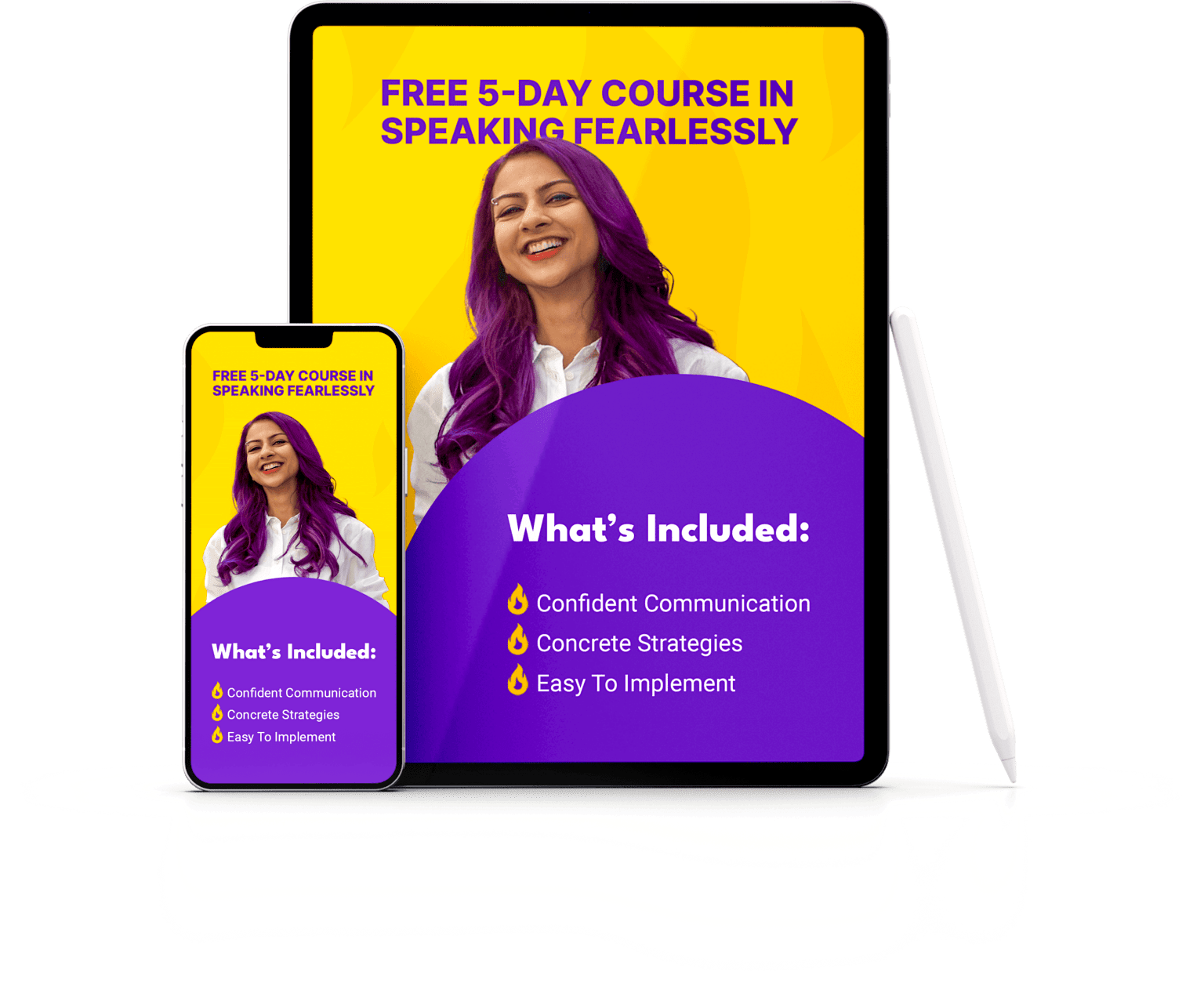Let’s face it – how you say something is just as important as what you’re saying. And as you grow your business or grow in your career, you’ll be speaking on different stages, platforms and through different mediums: one day you might be addressing a live audience on a stage, and the next, being interviewed on a podcast, or delivering a presentation on Zoom or Teams.
Table of Contents

Anytime that you want your message to resonate with an audience, your speaking style plays a pivotal role in ensuring that you deliver with impact. Each platform and medium has its unique demands, and understanding how to adapt your speaking style accordingly can make a significant difference in your ability to engage, influence, and inspire.
In this article, I’m sharing with you the nuances of public speaking across different platforms and giving you tips to help you excel anywhere you speak.
Section 1: The Skill of Stage Presence
Speaking on a stage should be a dynamic and exhilarating experience. Whether you’re giving a keynote speech or participating in a panel discussion, your presence on stage is crucial. And by presence, I don’t just mean body language.
Stage presence, just like executive presence, is about the confidence, charisma and calmness that you exude on stage. Your talk or presentation is an opportunity for you to create an experience.
This is how to do it:
1. Stepping into an amplified version of yourself.
The best speakers tap into the most passionate, energetic, and engaging aspects of their personalities and intentionally bring them out on stage.
This isn’t being inauthentic – it’s capitalizing on the fact that auditoriums are large, impersonal spaces, so someone standing on stage can be several hundred meters away from the audience. This means that the speaker has to make an extra effort to come across as “close”.
Show your passion, clarity and authenticity by creating an experience for the audience through your voice, body language and energy. Which brings us to…

2. Body Language and Gestures on Stage
On stage, your body language can either amplify your message or undermine it. Stand tall, occupy space, and use deliberate gestures to emphasize your points.
Confidence on stage is all about striking a balance between too many gestures or not enough. Between being rooted to one spot like a statue or walking back and forth across the stage repeatedly like a lion in a cage. And the best way to achieve that balance is rehearse with your gestures and positioning.

3. Voice Modulation
You might be more monotonous than you think. Your voice can be your most powerful ally or your biggest enemy when it comes to getting your message to land.
Remember the 5P framework – vary your pitch, pacing, add in pauses, be clear in your pronunciation and enunciation and project your voice with clarity.
Slow down for emphasis, raise your voice to convey excitement, and lower it for dramatic effect. Mastering vocal modulation exponentially enhances your stage presence.
4. Audience Interaction and Connection
This is where even the more experienced presenters go wrong: they forget that any presentation or talk is a two-way conversation, not a one-way lecture.
Engage with your audience through eye contact, smiles, and acknowledging their presence. Interact with them by asking questions or sharing relatable anecdotes. Pro-tip: aim to engage the audience after every 5-6 slides in your presentation so that they never feel left out.
Building a connection with the audience fosters a positive rapport and keeps them attentive. And attentive audiences are more likely to register and remember your message.

5. Adaptability
On stage, your biggest asset is that you get live, direct feedback right in front of you. Use this to your advantage: learn to observe the audience’s energy and attentiveness as you speak.
When you notice their attention waning, make an effort to re-engage them. Ask if you’re going too fast. Or if your content is too basic or too advanced. Introduce humor to get them to lighten up if the mood is too serious or monotonous. The best speakers can adapt on the fly, instead of getting stuck to a script.
Section 2: The Art of Being a Podcast Guest
If you’re an entrepreneur or if you have ambitions to become a thought leader, you should absolutely be speaking on podcasts. Being an effective and impactful podcast guest requires a different set of skills compared to stage speaking. Let’s take a deep dive into how you can adapt your speaking style for podcasting:

1. Tone and Delivery
Even though a lot of podcasts now have videos – a huge number are audio-only. This means that your voice is now your primary tool. Pay attention to your tone and delivery. Speak naturally, as if you’re having a conversation with a friend. Avoid sounding overly rehearsed or like a radio announcer. Use inflection to convey enthusiasm or emphasize key points.
Pro-tip: even though the audience can’t see you – if you smile and use gestures, that will come across in the way you’re speaking.
2. Conversational Flow
Podcasts thrive on conversational dynamics. You’re not there to deliver a monologue. As a guest, your job is to give crisp, clear and concise responses that let the host ask follow up questions.
Allow for pauses, laughter, and spontaneity. A conversational flow makes your interview relatable and enjoyable to listen to.

3. Preparation
Don’t give in to the temptation of asking the host for the questions before hand and practicing your responses. Unless you’re a pro, your responses will come across as robotic and poorly rehearsed. Also – when you write your responses out, you’re more likely to make it sound academic instead of like a natural conversation.
I’m not recommending that you don’t prep at all. But do your preparation in the form of doing research on the podcast, the host, the topics and bringing relevant stories.
Section 3: The Challenge of Online Presentations
The most seasoned speakers that I’ve met often hate delivering online presentations. “There’s no rapport with the audience”, they say. “I find it hard to bring the same level of energy when I present online”. This is exactly why you need to adapting your speaking style for online presentations so that you bring the fun, interactivity and energy back.
1. Visual Impact
Create a visual experience in your online presentation.
Make sure you’re well-lit and your camera is at eye-level. Having it too high makes you seem small and un-authoritative and having it too low makes you look dominating.
Develop minimalistic slides with keywords instead of full sentences so that you don’t need to read off of them.
And pro-tip: Start the presentation with yourself on full screen instead of sharing your slides from the beginning. This way you’ll get a chance to do an intro with your video on full screen – this will help the audience create more of a connection with you.

Photo by Karolina Grabowska:
2. Engaging Delivery
Keep your audience engaged by maintaining eye contact with the camera, not just looking at yourself or your presentation. (Pro-tip: a teleprompter works well here).
Use hand gestures, and vary your facial expressions. Your enthusiasm and engagement will come through the screen.
Remember – just because you can’t see them doesn’t mean they’re not there. It’s your job as the presentation deliverer to bring engagement, energy and enthusiasm.
3. Technical Proficiency
Familiarize yourself with the virtual platform you’re using. Test your equipment, including audio and video, in advance. Ensure a stable internet connection to prevent disruptions. Technical proficiency reduces distractions and enhances your credibility.
And remember – if things do go wrong, just take a deep breath and work on solving the issue instead of feeling unsettled.
4. Interactive Elements
Strategically engage the audience throughout your presentation – ask them questions, build in polls, add breakout rooms. If you can break the monotony of you presenting slide after slide, you’re winning.
Engaging your audience actively keeps their attention and involvement.

5. Setting expectations
I’ve discovered that if you set the right expectations at the outset with the audience – that you’ll be asking questions and interacting instead of just presenting – they are likely to be more open to interacting with you throughout the presentation.
Decide ahead of time if you’d like to take questions during your presentation or afterwards and clarify that at the beginning so that they know what to expect and so that they don’t feel left out. As a pro speaker, it’s your job to make the audience feel seen, heard and understood.
Adapting your speaking style across different platforms is a skill that can significantly enhance your ability to communicate effectively.
Whether you’re on stage, being interviewed on a podcast, or delivering an online presentation, mastering these nuances will help you engage your audience, convey your message, and leave a lasting impact. Remember that practice, continuous learning, and feedback are key to becoming a versatile and impactful speaker across diverse mediums.
If you want to work with an amazing coach who can guide you through this process of overcoming your stage fright, might I recommend myself? Find out how you can work with me and take advantage of my 10,000+ hours on stage and on camera to become a better speaker.



